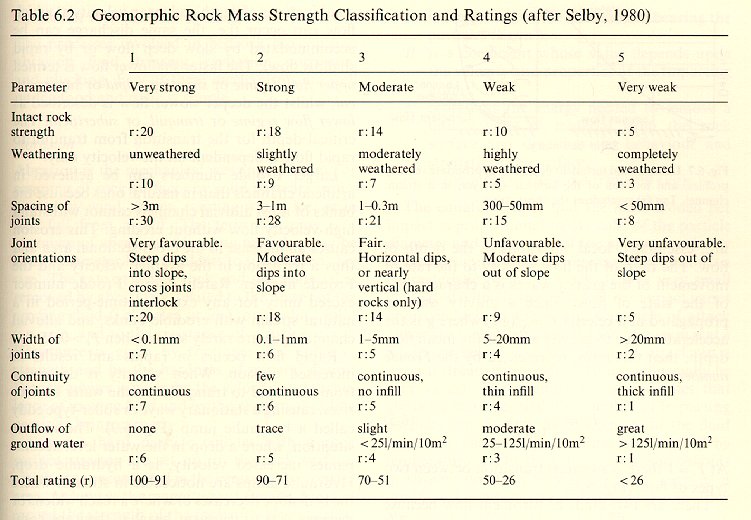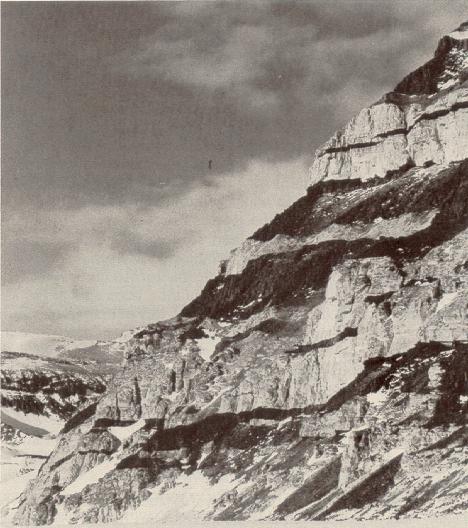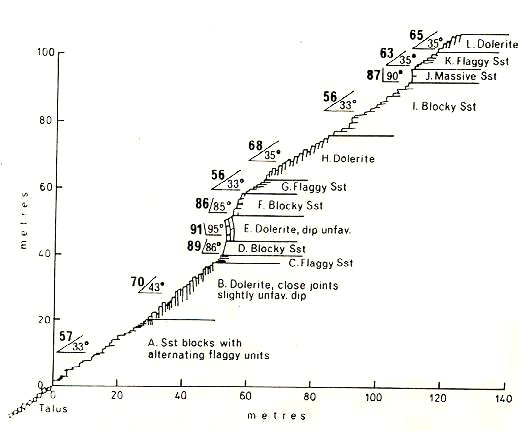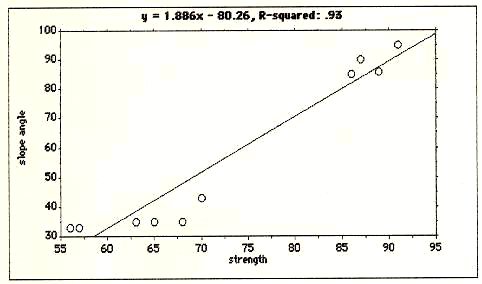
STRENGTH OF ROCK
Rock strength can be
dependent on many different factors. A scheme devised by M.J. Selby incorporates
7 factors:
1. Strength of intact rock
2. Degree of weathering
3. Joint Spacing
4. Joint orientation
5. Joint width
6. Joint continuity and infill
7. Flow of ground water through joints
(see table 7.2 in text).
Selbyís approach allows QUANTIFICATION of these factors so that the strength
of a rock can be measured.

1. Strength of
intact rock (20%) - depends mainly on mineral composition and rock structure.
Granite, for example, is mainly hard feldspar and quartz grains which interlock,
making for a relatively strong rock. Shale is mainly soft clay minerals with a
platey structure which flakes easily -> relatively soft.
Note: General rule of thumb: igneous and
metamorphic rock = fairly hard; clastic sedimentary rock = fairly soft;
limestone varies e.g. chalk = soft, other types of limestone can be quite hard.
2. State of weathering (10%) - Weathering changes hard minerals into softer ones and loosens up the structure of a rock -> reduced strength (note: complete weathering creates soil). This means that even a hard rock like granite can be a lot softer if itís highly weathered.
3. Joint spacing (30%) - all cohesive strength is lost along a joint - the greater the density of joints, the weaker the rock (close spacing results in a greater number of joints).
4. orientation of joints (20%) - dip into slope = stronger; dip out of slope = weaker; can be graded accordingly - see Table 7.2 in text.
5. Width of joints (7%) - affects cohesion, friction and water movement - the wider the joints the weaker the rock.
6. Continuity of joints and amount of joint infill with soil (7%) - Thick infill -> weaker rock, because strength of rock becomes strength of infilling soil (i.e. no points of rock contact along joint plane - all shear stress carried by weak soil layer in the joint).
7. Ground water outflow (6%) - as in soil, water can develop positive pressure in joints in rock. This water pressure can push rocks apart, effectively lowering friction and decreasing strength. The water pressure can be estimated based on outflow of water from the rock (table 7.2).
Main Points
1. Joint characteristics can account for up to 70% of rock strength - a highly
jointed granite can be less resistant to erosion than a compact unjointed
sandstone.
2. In the absence of joints, the initial rock strength and the state of
weathering become most important.
Example rock slope from Antarctica: alternating beds of dolerite (a hard volcanic rock) and various types of sandstone (some hard, some soft).


Measurement of rock mass
strength (Table 7.2) and slope angle.

Example Questions:
1. Explain why joint characteristics are so important in determining strength of a rock mass.
2. Outline Selby's approach to the quantification of rock strength.